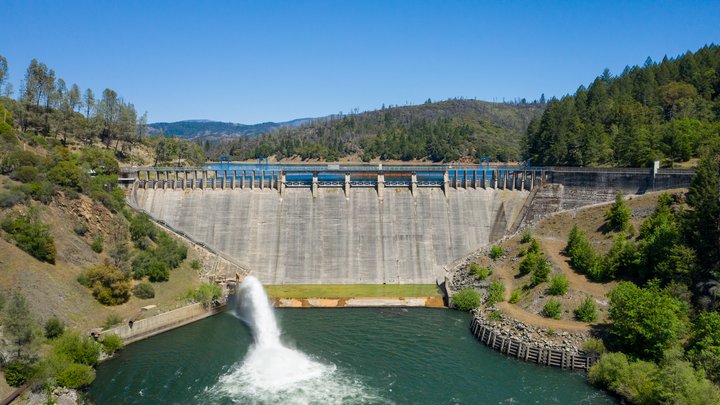UPDATE, 3:18 p.m.:
In response to the press release below, PG&E spokesperson Deanna Contreras emailed the following statement:
PG&E has received a notice of intent to sue from the Friends of the Eel River. The potential claims described in the notice are without merit. PG&E is strongly committed to environmental responsibility, and we are operating the Potter Valley Project in full compliance with the National Marine Fisheries Service’s (NMFS) Biological Opinion (BiOp) and its incidental take statement, which is incorporated into the Potter Valley license.
For the past 100 years of PG&E owning and operating the Potter Valley Project, PG&E has complied with the licenses issued by the Federal Energy Regulatory Commission (FERC) authorizing operation of the Project. The terms of PG&E’s current license, which remain in effect until the Project is licensed or surrendered by FERC, include requirements to comply with all environmental laws, including the endangered species act.
FERC set the expiration date of the Project more than 25 years ago. Upon expiration of a license, the Federal Power Act requires FERC to issue an annual license, which renews automatically, with the same terms and conditions for the project, until it’s relicensed, transferred or decommissioned. That means PG&E will continue to own and operate the Potter Valley Project safely under the existing license conditions until the project is transferred or FERC issues a final license surrender and decommissioning order.
###
Original post:
Scott Dam. | Photo by Kyle Schwartz of CalTrout, used with permission.
###
Press release:
Eureka, California - A coalition of environmental and fishing groups has notified Pacific Gas and Electric (PG&E) that its two obsolete dams on the Eel River are violating the federal Endangered Species Act by harming federally protected salmon and steelhead.
The five groups – Friends of the Eel River, California Trout, Trout Unlimited, Pacific Coast Federation of Fishermen’s Associations, and the Institute for Fisheries Resources – sent a letter required by the Endangered Species Act to PG&E last week. The legal notice states the Potter Valley Project dams and diversion are causing take of Chinook salmon and steelhead, and that to the extent PG&E had federal permits to harm listed species, that coverage expired April 14.
Alicia Hamann, executive director of Friends of the Eel River, said the groups intend to take the utility to federal court to seek protections for salmon and steelhead harmed by PG&E’s Potter Valley Project. “A century after Scott Dam blocked passage to the Eel River’s headwaters, PG&E’s license to operate the Potter Valley Project has expired. The Eel River dams must now be removed,” Hamann said. “Until the dams are removed, PG&E must operate the Potter Valley Project to minimize impacts to critically imperiled Eel River Chinook salmon and steelhead.”
Scientists estimate that historically the Eel River saw 800,000 Chinook salmon return in good years, but today, only about 3,000 Chinook come back. Vivian Helliwell with the Institute for Fisheries Resources, a fishing industry group, emphasized the impact low Eel River salmon numbers have on fishing vessels working the Pacific Coast. “The fishing industry didn’t block upstream salmon habitat, PG&E did,” said Helliwell, “but massive losses of salmon from the Eel River have been devastating to coastal fishing-dependent communities. Helping Eel River salmon recover will help restore lost jobs and income for our fishing families.”
Trout Unlimited’s Charlie Schneider noted that for the last 20 years, PG&E has operated the Potter Valley Project under restrictions set by federal fisheries biologists to protect Eel River fisheries. “The National Marine Fisheries Service is clear that the permit ended last week. Now the agency has concluded not only that those protective measures were inadequate, but that the Potter Valley Project is negatively impacting salmon and steelhead in ways the agency never allowed. The Eel is one of the best opportunities for wild salmon recovery in California, until they remove their dams, PG&E must do more to reduce their impacts to fish than continue business as usual.”
While some Russian River agricultural interests have complained about the prospect of Eel River dam removal, Darren Mierau of California Trout says “Our studies have clearly shown that dam removal is what’s best for the health of the Eel River and there are technical solutions that could provide diversions from the Eel River to the Russian without dams. Whether Russian River interests want to invest in a safe, resilient, 21st century water supply is ultimately up to them. Either way, it’s time for Eel River salmon and steelhead to get the protection they need.”
###
DOCUMENT: Notice or Intent to Sue Under Endangered Species Act
###
PREVIOUSLY:
- PG&E Tells Regional Commission It’s Thinking About Selling or Abandoning Potter Valley Dams, Which Take Water Out of the Eel and Send It South
- PG&E to Sell Off Potter Valley Project Dam Project, Which Diverts Eel River Water South; Friends of the Eel Vows to Keep Up Fight
- Friends of the Eel Decries ‘Secret Plans’ For Future of River-Draining Potter Valley Dams; Board of Supes Meets on Issue Tomorrow
- Mendo County Stakeholders Want to Take Over the Potter Valley Project, Which Diverts Water From the Eel; Local Enviros Say That Spells Trouble
- PG&E Announces That It’s Now Accepting Bids on Potter Valley Dams, Which Take Water From the Eel Put it in the Russian
- PG&E Says It Will Abandon Efforts to Sell or Relicense Eel River-Diverting Dams at Potter Valley
- Humboldt County Joins North Coast Coalition Seeking to Take Over the Potter Valley Project, Which Diverts Water from the Eel River
- Tribes Say They’ve Been Left Out of the Process on Potter Valley Project, but Congressman Huffman Begs to Differ
- Local Coalition Advances Plan to Remove Scott Dam on the Eel River, Acquire Potter Valley Project From PG&E
- Regional Coalition Looking to Take Over Potter Valley Project Hits Snag as FERC Denies Request
- The Potter Valley Project’s License Expires Today

CLICK TO MANAGE